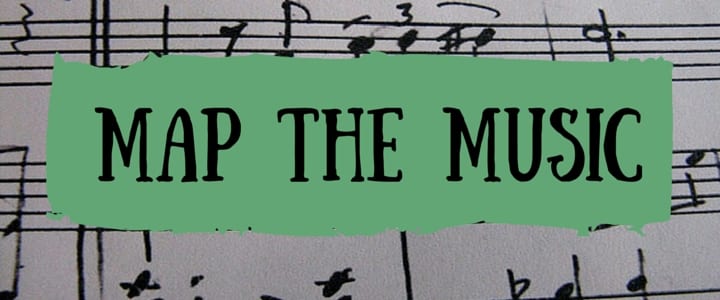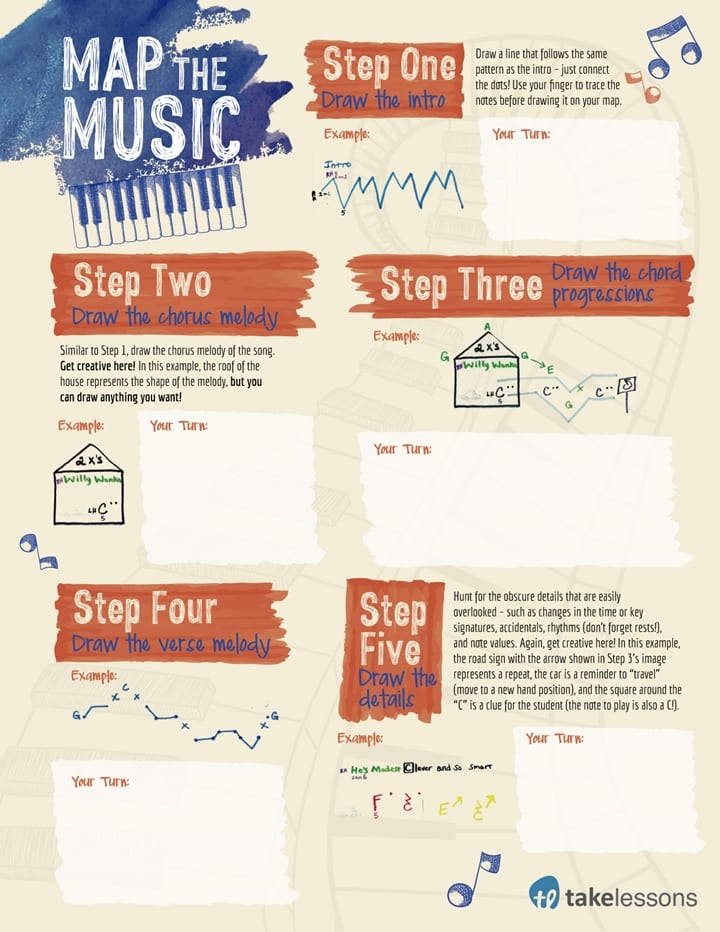Struggling with a particular piano piece? Don’t stress. It may just be time to take a step back and get your bearings. Read on as Spring Lake, MI piano teacher Val L. shares a piano exercise to try…
So you’ve been trying to learn a challenging piece of music for an upcoming piano recital or event, but there are still some parts that just seem to fall apart. If you are following the typical routine of playing it over and over, and making the same mistakes over and over, why not try a new approach?
Think of your song as a map. You have to get from point A to point B without any wrong turns that could result in you getting hopelessly lost and giving up! It’s time to take a step away from the keys and get out your markers, colored pencils, and a nice big piece of paper. It’s time to map the music!
Let’s give your brain the clues it needs to make it through the dense, foggy areas and avoid the potholes and pitfalls. Every piano song has its challenges – that’s what makes it interesting! Creating a visual tool, like a map, will help you navigate your way through a challenging piece of music.
As an example, here’s what my student came up with when we mapped out “Wonka’s Welcome Song” from Charlie and the Chocolate Factory (sheet music here).
Following the steps below, this piano exercise will bring out the most important elements of the piece, helping you remember the details and internalize the melody and harmony. But the most fun part of the exercise is that you have the freedom to get creative! Your drawing may be similar to my student’s example above, or it may not — it’s up to you!
Now Let’s “Map the Music”!
First, you’ll want to make a copy of your music. This is legal if you bought it and are using it only for your own study. Next, answer the following questions before you begin:
- Is there an intro? A bridge? Transitional measures? A coda preceded by a cadenza?
- Have you identified the main theme? The secondary theme?
- Are there sections that repeat?
This will give you a basic understanding of how the music is laid out and an outline to follow as you work through the piece.
Map the Music – Draw the Melody & Harmony
For each section you will want to identify the important details. Use different colors to draw the melody, the harmony, and the chord progression.
Draw a treble clef to show where the right hand plays. Use a different color to draw a bass clef that shows where the left hand plays. Think of these symbols as road signs in your sheet music to alert you to a change or a new pattern. This is especially helpful when the hands switch clefs.
Drawing the melody is as simple as doing a “dot-to-dot.” Draw a line that follows the same pattern as the melody – just connect the dots! Use your finger to trace the notes before drawing it on your map. Pay close attention to the following:
- Are there skips?
- Is there a sudden change in the direction of the pattern?
- Does the pattern repeat anywhere else in the song?
Start by writing the letter name of the first note (keynote) and then draw the line going up if the notes step up, down if the notes step down. Use an X to represent skips and draw longer lines for bigger leaps. If there are groups of notes that repeat, draw a line with a number above it showing how many notes repeat. Using different colors for melody and harmony will show parallel and contrary patterns.
Map the Music – Mark the Details
The next step in this piano exercise is to hunt for the obscure details that are easily overlooked
- Time Signature – Is it cut time? Does it change anywhere in the piece?
- Key Signature – How many sharps/flats? Does it change anywhere in the piece?
- Accidentals – Don’t forget to mark the most common culprits for tripping you up!
- Rhythm – Where are the rests? Don’t ignore them!
- Note Values – What is the shortest note value? (Eighth notes? Sixteenth notes?) Use them to establish your steady rhythm! Take the time to write and clap the rhythm.
Map the Music – Extra Tips
- Focus on the tricky measures – Make note of the measures that have been the most difficult.
- Color code – Use different colors to circle or highlight the details. Maybe it’s the rhythm, or an accidental, or a fingering that has been giving you trouble.
- Illustrate – Use your imagination to draw the melody or use a simple picture to sort out the fingering.
Ready to try it with your own piano music? Here’s an even-simpler breakdown:
Want to download the printable version of the worksheet? Get it here: Map the Music Printable PDF
By simplifying the music and creating a visual that makes sense to you, the process of learning and/or memorizing will be much more manageable. The goal of this piano exercise is to give your brain a “snapshot” of the piece so you can easily recall where you are at if you get lost. Be creative, use your own ideas, and consult your piano teacher to make stronger connections with the music. Good luck!
 Post Author: Val L.
Post Author: Val L.Val L. teaches piano lessons in Spring Lake, MI. She earned her Associate of Arts degree from William Tyndale College and has been teaching piano for more than 10 years. Learn more about Val here!
Photo by m kasahara
Suzy S.
![Feeling Stuck? Try This Fun Piano Exercise [Printable]](/_next/image?url=https%3A%2F%2Ftakelessons.com%2Fblog%2Fwp-content%2Fuploads%2F2015%2F06%2FMap-the-Music.jpg&w=3840&q=75)



